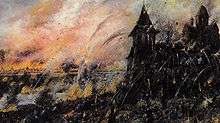Tokhtamysh
| Tokhtamysh | |
|---|---|
|
Khan Shahanshah | |
 Tokhtamysh and the armies of the Golden Horde rally in front of Moscow, 1382. | |
| Reign | 1380-1395 |
| Coronation | 1378 |
| Predecessor | Urus Khan, Mamai |
| Successor | Edigu |
| Born | White Horde |
| Died |
1406 Tyumen |
| House | Borjigin |
| Dynasty | Golden Horde |
| Religion | Islam |
Tokhtamysh (tat. Tuqtamış) [n 1] or Tokhtamısh[1] (died 1406) was the prominent khan of the Blue Horde, who briefly unified the White Horde and Blue Horde subdivisions of the Golden Horde into a single state. He was a descendant of Genghis Khan's grandson, Tuqa-Timur.
Early campaigns
Tokhtamysh appears in history in 1376, trying to overthrow his uncle Urus Khan, ruler of the White Horde, and fleeing to the great Timur. Tokhtamysh outlived Urus and both his sons, and forcefully ascended to the throne of the White Horde in 1378, with Timur's backing.
Tokhtamysh dreamed of emulating his ancestors and made plans to reunite the Golden Horde. In 1380, he invaded the Blue Horde by fording across the Volga, and defeated Mamai during the Second Battle of the Kalka River. The ruler of the Blue Horde, Mamai, was killed shortly after the Battle of Kulikovo, marking Tokhtamysh's victory and the reunification of the Golden Horde.
Having reunited the Blue and White Hordes into the Golden Horde, in 1382, Tokhtamysh led a successful campaign against Russia as a punishment for the Kulikovo defeat - setting back, though not ending, the Russian aspiration to free themselves of Tatar rule. In just six years, Tokhtamysh had reunified the lands of the Golden Horde from Crimea to Lake Balkhash.
Campaign against Moscow
Dmitry Donskoy had raised a large army to defeat and suppress the Mongol–Tatar hordes, and, after defeating Mamai during the Battle of Kulikovo, could not raise another army against Tokhtamysh Khan. Realizing the enmity the unruly Dimitry had unleashed, Tokhtamysh marched against Moscow.
After three days of siege, Tokhtamysh was faced with a stalemate, until Donskoy's brothers-in-law opened the gates and allowed the massacre of the city's inhabitants.[2] The destruction of Moscow led to Dimitry's surrender to the authority of Tokhtamysh at the end of 1382. Tokhtamysh also took Donskoy's son hostage.

 Muscovites gather during the Siege of Moscow (1382).
Muscovites gather during the Siege of Moscow (1382). Warriors of the Golden Horde attack Moscow.
Warriors of the Golden Horde attack Moscow. Muscovites prepare for the Siege of Moscow (1382)
Muscovites prepare for the Siege of Moscow (1382)
Wars against Tamerlane

Believing he could defeat the Ilkhanate Chobanids and capture the disputed territories of the Caucasus since the days of Berke Khan, in 1385 Tokhtamysh, with an army of 50,000 (or five tumens), invaded Persia and took Tabriz. Returning north they took 200,000 slaves from the Caucasus, including tens of thousands of Armenians from the districts of Parskahayk, Syunik, and Artsakh.[3] This proved to be a fatal error for Tokhtamysh, who moved north from the Caucasus, thus allowing his Ilkhanate rivals to side with Timur, who annexed Persia to his own expanding kingdom. Furious, Tokhtamysh turned back and made war on his former ally.
Eventually, Tokhtamysh conceded defeat and withdrew to the steppe. However, in 1387 he suddenly invaded Transoxiana, the heart of Timur's realm. Unfortunately for Tokhtamysh, heavy snow forced him back to the steppe.
In 1395, the scenario reached its climax as Timur attacked the Golden Horde and defeated Tokhtamysh at the Terek. Timur sacked cities of the Golden Horde such as Azov (Tana), Astrakhan[4] and Tokhtamysh's capital, Sarai Berke. Timur captured artisans and craftsmen of the Golden Horde, and placed a puppet ruler, Koirichak, on the throne of the White Horde and appointed Temür Qutlugh khan of the Horde.
Tokhtamysh escaped to the Ukrainian steppes and asked for help from the Grand Duke Vytautas of Lithuania. In the great Battle of the Vorskla River (1399) the combined forces of Tokhtamysh and Vytautas were defeated by two of Timur's generals, khan Temur Qutlugh and emir (murza, visir) Edigu. The defeated Tokhtamysh was killed in Tyumen by Edigu's men in 1406.
He was the last khan who minted coins with Mongolian script.
Family
He had 8 sons;
- Jalal al-Din Khan ibn Tokhtamysh
- Karim Berdi
- Kebek Khan
- Jabbar Berdi
- Qadeer Berdi Khan
- Abu Sa'id Khan
- Iskander Khan
- Khoja Khan
See also
Notes
- ↑ The spelling of Tokhtamysh varies, but the most common spelling is Tokhtamysh .Tokhtamısh, Toqtamysh, Toqtamış, Toqtamıs, Toktamys, Tuqtamış, and variants are also in use.
References
- ↑ Kołodziejczyk 2011, p. 5.
- ↑ http://books.google.ca/books?id=kPwX2dW-V6sC&pg=PA57&dq=Tokhtamysh&hl=en&sa=X&ei=QZdwU7u1Au-IyAOE7ICwAw&ved=0CFUQ6AEwBw#v=onepage&q=Tokhtamysh&f=false
- ↑ The Turco-Mongol Invasions IV, Medieval Armenian History, Turkish History, Turkey
- ↑ http://books.google.ca/books?id=9JHwVtL7qDcC&pg=PA224&dq=Tokhtamysh&hl=en&sa=X&ei=QZdwU7u1Au-IyAOE7ICwAw&ved=0CDQQ6AEwAQ#v=onepage&q=Tokhtamysh&f=false
Bibliography
- Kołodziejczyk, Dariusz (2011). The Crimean Khanate and Poland-Lithuania: International Diplomacy on the European Periphery (15th-18th Century). A Study of Peace Treaties Followed by Annotated Documents. Leiden: Brill. ISBN 9789004191907.
| Tokhtamysh House of Qiyat (1206–1635) | ||
| Regnal titles | ||
|---|---|---|
| Preceded by Arab Shah Muzaffar |
Khan of the Golden Horde 1381–1397 |
Succeeded by Temür Qutlugh |
| Preceded by Timur-Malik |
Khan of the Blue Horde 1378–1395 |
Succeeded by Koirichak |